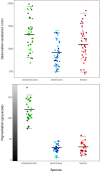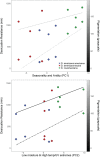Desiccation resistance and pigmentation variation reflects bioclimatic differences in the Drosophila americana species complex
- PMID: 31694548
- PMCID: PMC6836511
- DOI: 10.1186/s12862-019-1536-7
Desiccation resistance and pigmentation variation reflects bioclimatic differences in the Drosophila americana species complex
Abstract
Background: Disentangling the selective factors shaping adaptive trait variation is an important but challenging task. Many studies-especially in Drosophila-have documented trait variation along latitudinal or altitudinal clines, but frequently lack resolution about specific environmental gradients that could be causal selective agents, and often do not investigate covariation between traits simultaneously. Here we examined variation in multiple macroecological factors across geographic space and their associations with variation in three physiological traits (desiccation resistance, UV resistance, and pigmentation) at both population and species scales, to address the role of abiotic environment in shaping trait variation.
Results: Using environmental data from collection locations of three North American Drosophila species-D. americana americana, D. americana texana and D. novamexicana-we identified two primary axes of macroecological variation; these differentiated species habitats and were strongly loaded for precipitation and moisture variables. In nine focal populations (three per species) assayed for each trait, we detected significant species-level variation for both desiccation resistance and pigmentation, but not for UV resistance. Species-level trait variation was consistent with differential natural selection imposed by variation in habitat water availability, although patterns of variation differed between desiccation resistance and pigmentation, and we found little evidence for pleiotropy between traits.
Conclusions: Our multi-faceted approach enabled us to identify potential agents of natural selection and examine how they might influence the evolution of multiple traits at different evolutionary scales. Our findings highlight that environmental factors influence functional trait variation in ways that can be complex, and point to the importance of studies that examine these relationships at both population- and species-levels.
Conflict of interest statement
The authors declare that they have no competing interests.
Figures




References
-
- Bachli, Gerhard (2018). Taxodros: The database on Taxonomy of Drosophilidae.
Publication types
MeSH terms
Associated data
LinkOut - more resources
Full Text Sources
Molecular Biology Databases

